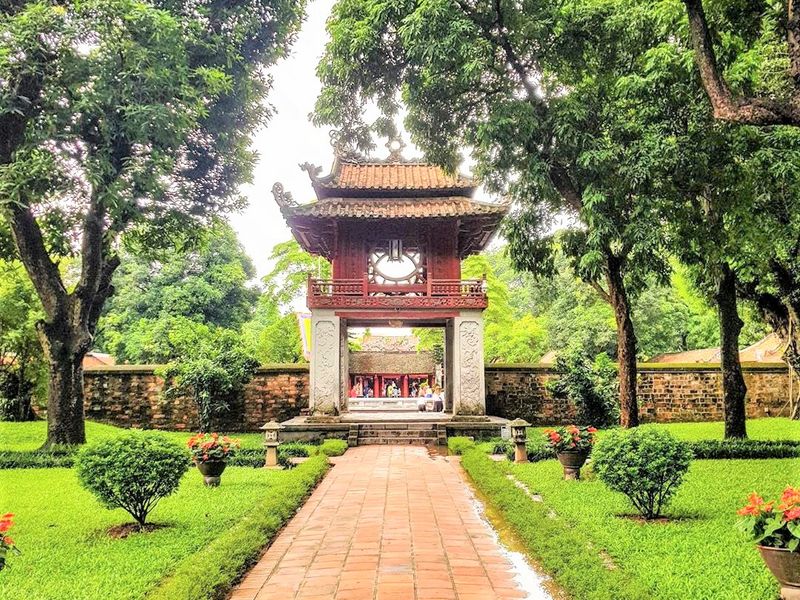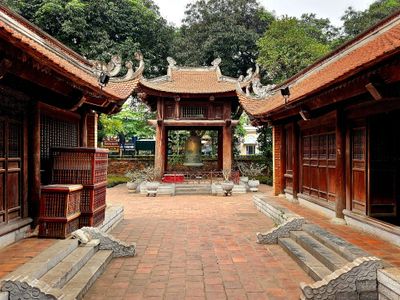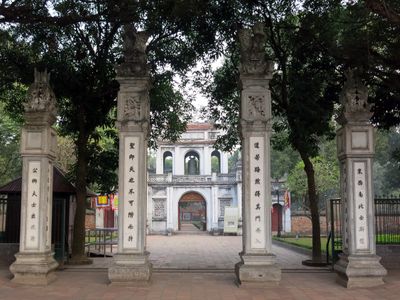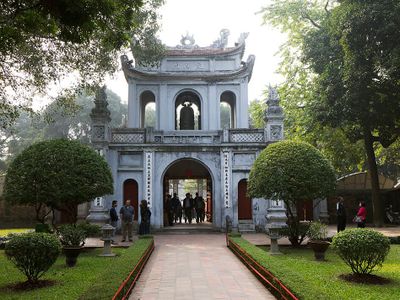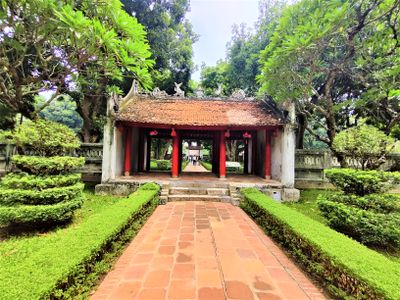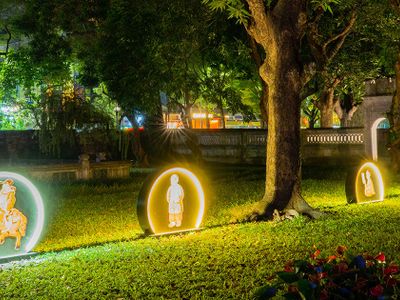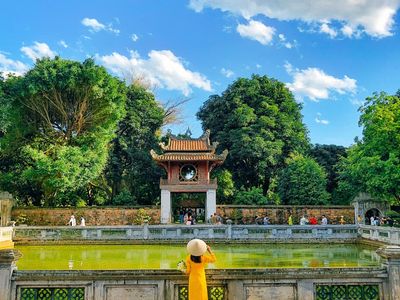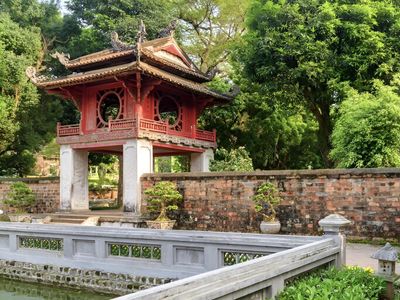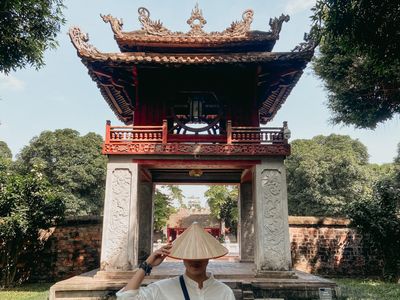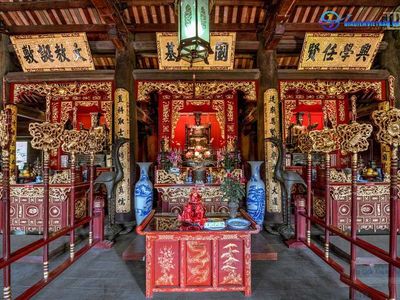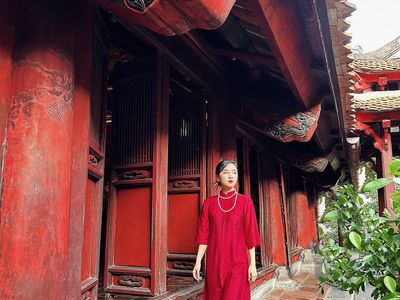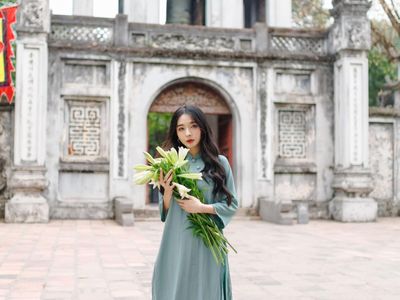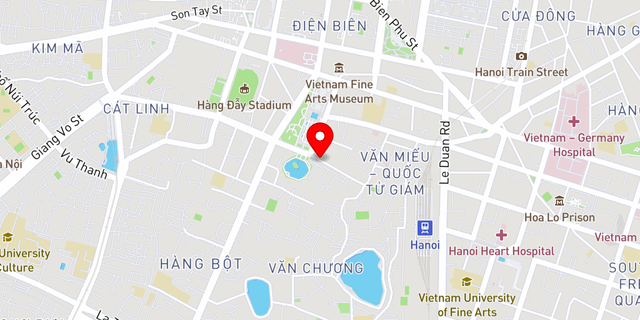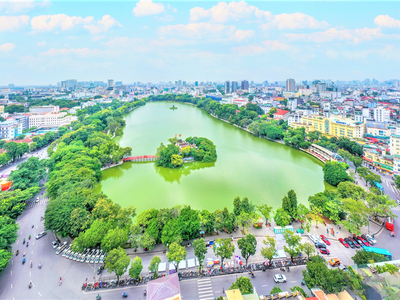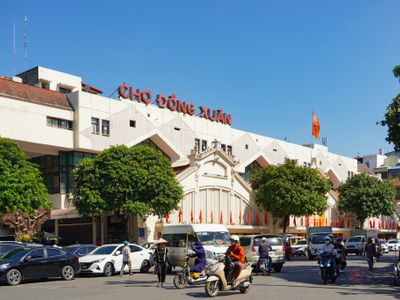Temple of Literature & National University
08:00 - 17:00(Closed)
No. 58, Quoc Tu Giam Street, Dong Da District, Hanoi
Sights & Landmarks
02438452917
http://vanmieu.gov.vn/
Related Services
General Information
Transportation Guides
To get to the Temple of Literature and National University, visitors can choose one of the following options:
-
Travel by bus: You can take one of the following bus routes: 32, 41, 23, 38, 02, and get off at the nearest bus stop to the Temple of Literature. From there, you can walk to the Temple of Literature.
-
Choose Double-Decker Bus Services: This is a capital city tour service that has only appeared in recent years. This service not only allows you to visit the Temple of Literature but also takes you to explore all the other famous landmarks and historical sites in Hanoi very professionally and conveniently.
-
Using inner-city bicycle tours: This is a service offered by travel companies to provide a unique and enjoyable experience for tourists when exploring Hanoi by bicycle.
-
Taxi or motorbike taxi: In Hanoi, motorbike taxis and regular taxis are readily available, making it easy for tourists to call a taxi to go to the Temple of Literature and National University to visit and explore.
-
Traveling by personal vehicle: If you have your own vehicle, you can look up the map or ask locals for directions to choose the most suitable route to avoid going on one-way streets.
Ticket Prices
The Temple of Literature and National University is open every day of the week, including weekends and holidays. Opening hours are 7:30 am in winter, 8:00 am in other seasons and closing time is 6:00 pm.
The ticket price to visit the Temple of Literature is 30.000 VND/person/visit. If you belong to one of the following categories, ticket prices will be free or 50% reduced:
-
Free tickets for children under 15 years old and people with special severe disabilities
-
50% discount on the ticket prices for people in remote areas, ethnic minorities, the elderly over 60 years old, people with severe disabilities, and people with meritorious service to the country.
Attractions
History of Temple of Literature and National University
Construction began in August 1070 under the reign of King Ly Thanh Tong, the Temple of Literature, apart from its function of worshiping Confucian saints, was also the first royal school - a place to educate the Crown Princes. The first student of this royal school was Prince Ly Can Duc, who later became King Ly Nhan Tong. In 1076, this first student, after ascending the throne, established an educational institution next to the Temple of Literature. This school was exclusively intended for the children of kings, high-ranking officials, and nobility, so it was named Quoc Tu Giam.
In 1253, under the reign of King Tran Thai Tong, Quoc Tu Giam was renamed the National Academy. At this time, the school was expanded and started accepting not only royal offspring but also exceptional commoners who demonstrated outstanding academic abilities. During the reign of King Tran Minh Tong (1300 - 1357), Chu Van An was invited to hold the position of National Tutor, equivalent to today's principal position. He is responsible for managing all activities of Quoc Tu Giam and directly teaching Crown Prince Tran Vuong.
Architecture of Temple of Literature
The complex of the Temple of Literature is a large rectangular piece of land covering an area of 54,331 square meters, imbued with the architecture of the early Nguyen Dynasty. The Temple of Literature campus is surrounded by four solid brick walls.
The Temple of Literature is designed according to a Confucian architectural layout with each class and each area following the North-South axis. Entering from the main gate are four pillars and two Ha Ma steles on both sides. Going inside the Noi Tu areas is separated by a lake, a large courtyard or a walkway with wide spaces on both sides. Before entering each area, you'll pass through a system of gates including one main door and two side doors on both sides. All the entrances and exits to the Noi Tu area, temples, shrines, and Thai Hoc house are designed with roofs with a pair of dragons flanking the moon, imbuing the ancient oriental architectural style.
Van Lake
Located right in front of the entrance to the Temple of Literature, Van Lake, also known as Giam Lake or Minh Duong Lake, is the first point of interest to visit when visiting the Temple of Literature. According to historical records, Van Lake is a large, vast lake, measuring up to 19,000 square meters, within the overall complex of the Temple of Literature historical site.
In the middle of Van Lake is Kim Chau mound. Phan Thuy Duong was built on Kim Chau mound. Phan Thuy Duong is the place where literary commentary sessions by Confucian scholars of the ancient capital took place.
Temple of Literature Main Gate
Temple of Literature Main Gate is the three-entrance gate outside of the relic site. Consists of 3 doors with the door being built on 2 tall floors. The upper floor bears the inscription "Van Mieu Mon" in ancient Chinese characters. Located in front of the Temple of Literature are four pillars of the gate in the middle and two Ha Ma steles on both sides.
Legend has it that in the past, they were high-ranking officials or nobility, when passing through the Temple of Literature, they had to put down their hammock, get off their horse-drawn carriage, and walk at least from the Ha Ma stele on one side to the Ha Ma stele on the other side before continuing. That is enough to understand how solemn and meaningful the Temple of Literature is.
Dai Trung Gate
Dai Trung Gate is the second gate of the Temple of Literature, go straight in through the main gate of the Temple of Literature. Dai Trung Gate consists of three compartments constructed on a high brick base and roofed with traditional tiled roofs, following the architectural style of ancient temple structures.
In front and behind Dai Trung Gate, there is a spacious area filled with greenery, ponds, and small parallel pathways, creating a sense of solemnity, elegance, and tranquility.
Pavilion of the Constellation of Literature
Pavilion of the Constellation of Literature is a square, two-story pavilion with a height of nearly 9 yards, featuring 4 lower and 4 upper roofs. This structure was constructed by Governor Nguyen Van Thanh in 1805 during the Nguyen Dynasty. The pavilion is built on a square ground with each side measuring 6.8 meters.
The architecture of Pavilion of the Constellation of Literature is very unique, featuring a traditional Vietnamese style pavilion with the lower floor supported by four square brick pillars, each measuring 1 meter in length. These pillars are intricately carved with delicate and detailed floral patterns. The upper level of Pavilion of the Constellation of Literature is constructed from beautifully lacquered and gilded wood with a double-layered, red-tiled roof, creating a very special 8-roof structure. The four sides of the upper level are adorned with round windows, likened to shining suns or stars.
Thien Quang Well and Doctoral Stele
The Thien Quang Well was built in a square shape to symbolize the earth. Located right behind the Pavilion of the Constellation of Literature with round doors symbolizing heaven. These two symbols imply that all the essence of heaven and earth are gathered at the cultural and educational center in the middle of the ancient imperial capital of Thang Long.
On both sides of Thien Quang Well are two rows of large stone steles called doctorate stele. Each stone stele is a unique work of art, intricately carved and holds great spiritual significance. 82 doctoral steles are erected on the backs of 82 green stone turtles, and they serve to record and honor the 82 valedictorians in the examinations of various feudal dynasties in ancient Vietnam.
Dai Thanh Gate and the shrine area
Like Dai Trung Gate, Dai Thanh Gate also has 3 compartments with a row of columns in the middle and two rows of columns on the front and back porch. Stepping through the Dai Thanh Gate, visitors will come to a vast courtyard paved with Bat Trang ceramic tiles, leading to the central worship area of the Temple of Literature, known as the Dai Bai Duong.
Dai Bai Duong comprises nine sections, but only the two side sections have walls, while the front and rear sections are left open. This is the place where ceremonies and rituals were conducted during ancient springtime festivals. Within the Dai Bai Duong, only the central section contains the altar for worship, while the other sections remain empty.
Khai Thanh Temple
Khai Thanh Temple is the last structure of the ancient Quoc Tu Giam relic site. This is the place to worship Confucius's parents, Thuc Luong Ngot and Nhan Thi. In the past, this area served as a residential area with 150 rooms for students, also known as the Thai Hoc area, here many talents were trained for various dynasties.
However, in 1946, during an attack by the French colonial forces, this area was completely destroyed. Subsequently, Khai Thanh Temple was newly built and preserved to this day.
Tips
When visiting the Temple of Literature and National University, tourists should pay attention to the following tips:
-
Dress appropriately, wear neat, clean, and serious.
-
Avoid wearing hats or caps, smoking, or carrying flammable or explosive materials within the temple grounds.
-When offering incense, only light one incense stick in the designated area.
-
Speak softly and help preserve the environmental cleanliness and beauty of the site.
-
Do not superstitious or fraudulent activities, as well as gambling within the Temple of Literature.
-
Do not damage, write, draw, stand, or sit on any artifacts. Do not touch the turtle statues, doctorate stelae, and other exhibited items.
According to experience visiting the Temple of Literature and National University, the time to visit this monument only takes 1 to 3 hours. Therefore, tourists should have a schedule to visit other places near the Temple of Literature and National University such as Hanoi Railway Station, Quan Su Pagoda, Hoa Lo Prison, ...
Above are detailed information about the Temple of Literature and National University that Justfly wants to share with you. Hopefully through the useful information, visitors can fully explore the Temple of Literature and National University.
Customer Reviews
5,0 /5
5 reviews
Frequently Asked Questions
What is the opening time of the Temple of Literature and National University?
Opening hours of the Temple of Literature and National University are from 8 a.m to 17 p.m every day of the week.
How much is a ticket to visit the Temple of Literature and National University?
The ticket price to visit the Temple of Literature is 30.000 VND/person/visit. If you belong to one of the following categories, ticket prices will be free or 50% reduced:
-
Free tickets for children under 15 years old and people with special severe disabilities
-
50% discount on the ticket prices for people in remote areas, ethnic minorities, the elderly over 60 years old, people with severe disabilities, and people with meritorious service to the country.
How to get to the Temple of Literature and National University?
To get to the Temple of Literature and National University, visitors can choose one of the following options:
-
Travel by bus: You can take one of the following bus routes: 32, 41, 23, 38, 02, and get off at the nearest bus stop to the Temple of Literature. From there, you can walk to the Temple of Literature.
-
Choose Double-Decker Bus Services: This is a capital city tour service that has only appeared in recent years. This service not only allows you to visit the Temple of Literature but also takes you to explore all the other famous landmarks and historical sites in Hanoi very professionally and conveniently.
-
Using inner-city bicycle tours: This is a service offered by travel companies to provide a unique and enjoyable experience for tourists when exploring Hanoi by bicycle.
-
Taxi or motorbike taxi: In Hanoi, motorbike taxis and regular taxis are readily available, making it easy for tourists to call a taxi to go to the Temple of Literature and National University to visit and explore.
-
Traveling by personal vehicle: If you have your own vehicle, you can look up the map or ask locals for directions to choose the most suitable route to avoid going on one-way streets.
What to see and explore at the Temple of Literature and National University?
Some outstanding places you should visit, explore and check-in at the Temple of Literature and National University:
- History of Temple of Literature and National University
- Architecture of Temple of Literature
- Van Lake
- Temple of Literature Main Gate
- Dai Trung Gate
- Pavilion of the Constellation of Literature
- Thien Quang Well and Doctoral Stele
- Dai Thanh Gate and the shrine area
- Khai Thanh Temple
What to note when visiting the Temple of Literature and National University?
When visiting the Temple of Literature and National University, tourists should pay attention to the following tips:
-
Dress appropriately, wear neat, clean, and serious.
-
Avoid wearing hats or caps, smoking, or carrying flammable or explosive materials within the temple grounds.
-
When offering incense, only light one incense stick in the designated area.
-
Speak softly and help preserve the environmental cleanliness and beauty of the site.
-
Do not superstitious or fraudulent activities, as well as gambling within the Temple of Literature.
-
Do not damage, write, draw, stand, or sit on any artifacts. Do not touch the turtle statues, doctorate stelae, and other exhibited items.
